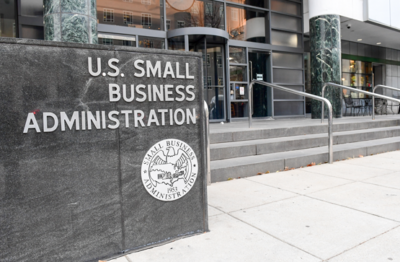Small business contract awards in 2021 reach all-time high
The Small Business Administration is trying to address the 40% decline in the small business industrial base over the last decade with new initiatives.
Best listening experience is on Chrome, Firefox or Safari. Subscribe to Federal Drive’s daily audio interviews on Apple Podcasts or PodcastOne.
Agencies made history in fiscal 2021 by awarding more total prime contract dollars to small businesses than ever before.
Data from the Small Business Administration shows not only did agencies surpass the governmentwide goal of 23%, but increased total spending with small firms by $8 billion.
Overall, the federal government spent $154.2 billion, or 27.23% of all prime contracts, with small businesses last year. SBA’s annual small business scorecard awarded 21 agencies an “A” or A+” grade for their efforts last year, which is actually down from the 22 agencies that received the highest marks in 2020. In 2020, agencies awarded more than $133 billion to small firms, which came to 26.5% of all prime contracts.
“The 2021 contracting achievements are great markers to the progress we are trying to lead with our equity and procurement reforms, in particular,” said Isabella Casillas Guzman, the SBA administrator, during a press conference on July 26. “With the historic reforms that we announced last year with the White House and the Office of Management and Budget and across the agencies, we are seeing progress. We made some significant changes to strategic sourcing. We started ensuring transparency by releasing disaggregated data and tracking those new entrants. We wanted to make sure we were managing to performance plans really focusing on small business contracting socioeconomic firms goals.”
Agency small business contracting success in 2021 extends not just to small businesses, but every socioeconomic category reached new highs.
SBA says agencies awarded 11% of all prime contracts worth $62.4 billion to small disadvantage businesses. This accomplishment met the Biden administration’s first goal of increasing the percentage of contracts going to SDBs to 11% by 2022. The next goal is to increase the SDB’s share to 15% by 2025.
Also for the first time, agencies surpassed the governmentwide goal of awarding 3% of all contracts to service disabled veteran-owned small businesses. SBA says SDVSBs received 4.41% of all prime contracts, which equals more than $25 billion.

“I think that the key now is that we are building on these results with major reforms, and trying to expand access to contracting for small businesses as we look forward into the future opening more doors for equity and opportunity, including where we have work to do for women-owned small businesses and HUBZone businesses,” Guzman said. “It’s about addressing capital challenges and simplifying processes and certifications to attract more small firms. It’s about helping more small businesses learn how to do business with the federal government, by funding expanded networks for small business centers, which we’ve done through the American Rescue Plan Act. I think that we need to meet our small businesses where they are and get more of those small businesses to do business with the federal government.”
40% fewer small businesses
These achievements come despite a small business industrial base that has decreased by 40% since 2012, and the number of new entrants into the federal market dropped by 60% over the last decade.
Guzman and other federal officials said they are trying to address the dwindling small business industrial base.
Pete Buttigieg, the secretary of the Department of Transportation, said a new notice of proposed rulemaking would make it easier for Disadvantaged Business Entities (DBEs), which is the DOT term for SDBs, to compete for infrastructure contracts. The notice is out right now for public comment.
“The DOT increased the number of small disadvantaged business prime contractors by 1.59% [in 2021]. And working with SBA, we have stepped up our reach and our capacity building work in order to help with issues like access to capital and bonding capacity,” Buttigieg said. “Right now we have an even greater opportunity, a once in a lifetime opportunity, I believe, thanks to the large investment in infrastructure and jobs that came through the president’s infrastructure vision and the bipartisan infrastructure law. Now we have to make sure that these dollars go to where they can do the most good and that we do a good job engaging DBEs to bring these projects to life.”
The Defense Department, which exceeded its small business contracting goal for the eight consecutive year, will soon issue its new small business strategy that will address industrial base challenges.
“We have to continue to look at removing and lowering barriers to do business with us. We have that high on our on our on our priority list,” said Bill LaPlante, the undersecretary of Defense for acquisition and sustainment, during the press conference. “We’ll have additional initiatives that we’re going to do to reduce barriers to entry, and aligning our small business with our national security imperatives for the country. Of course, our national security is related to our national economic security, they’re intertwined.”
Changes SBA is tracking
SBA’s Guzman said moving all socioeconomic categories to tier 2 of category management, which means agencies will receive credit toward their spend under management goals for awards to SDBs, women-owned small firms, service disable veteran-owned small businesses and HUBZone firms. SBA says this means 33,000 more additional firms are part of that higher level tiering category, which will create more access for contract opportunities
“We hope to see the pathways like that to government contracting yield more small business participation. When you talk to small businesses, some of the challenges that they have in participating in federal contracting is the complications of not being able to navigate the systems, whether that’s certification or how to get how to do business development and how to actually connect with agencies,” she said. “The outreach can’t be minimized from that perspective because that includes the technical assistance, the content, the knowledge, the support that small businesses need to be able to understand federal contracting. Then, of course, it’s on us to try to simplify the process. We’ve been working diligently in the Biden-Harris administration to simplify the certification process, leverage technology to try to improve that experience to get more small businesses to that first step in many cases of certification.”
Bibi Hidalgo, SBA’s associate administrator for government contracting and business development, said for the first time SBA is tracking new entrants into the federal contracting market
“We can get all the 24 cabinet and other agencies oriented around the fact that we need to increase our small business industrial base and go back to the historic numbers that we had previously,” she said. “[Contract] bundling is one of the major issues. So the administrator is working extremely hard every day with the cabinet members to make sure that we start to reverse course on contract bundling.”
Copyright © 2024 Federal News Network. All rights reserved. This website is not intended for users located within the European Economic Area.
Jason Miller is executive editor of Federal News Network and directs news coverage on the people, policy and programs of the federal government.
Follow @jmillerWFED







